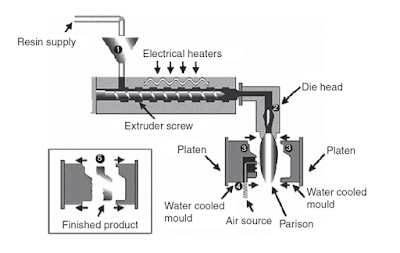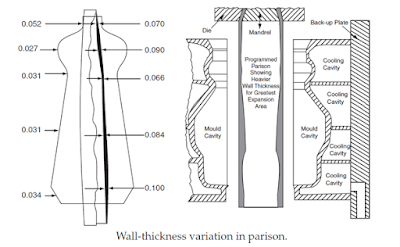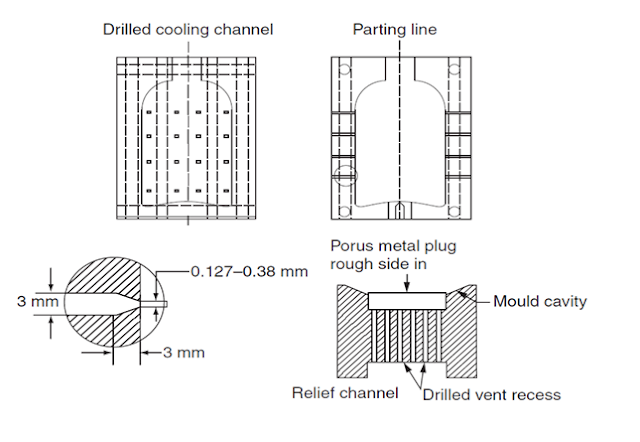1 .Blow Moulding Process
Ans:- Blow moulding is a plastic moulding process where a
thermoplastic material is heated to its forming temperature, which is below the
plasticising temperature of the plastic materials being used to form a hollow
tube called a parison Heated homogeneous plastic material is then placed
between two female mould halves.The two female mould halves are then closed and
compressed air enters via an open end of the parison via a blow pin or
needle.The air blown into the closed female mould halves forces the parison to
take the internal shape of the closed mould thereby forming the blown
component. The mould halves are cooled through suitable medium through the
entire process so that the blown parison when comes in contact solidifies
immediately. The two female moulds are then separated and shaped hollow
component is then ejected or allowed to drop out and the cycle is repeated
again.
2 .Five Stages in Blow Moulding Process
Ans:-
1. Plasticising or
melting the resin
2. Parison or preform
production
3.Inflation of the
parison or preform in a mould to produce the end part
4. Ejection of the
part
5.Trimming and finishing of the part
3 .Basic Blow Moulding Process
Ans:-
4. Parts of Extrusion Blow Mould
Ans:-
5. Applications of Extrusion Blow Moulded Parts
Ans:-
1.ANS=Packaging for
milk, fluids, medicines, cosmetics, etc.
2. Automotive fuel
tanks, oil bottles, air-ducts, and seat-backs, etc.
3. Consumer products
like toys, house-wares, sports goods, etc.
4. Drums for chemical
industries.
5. Bellow shaped
shields and double-walled carrying cases.
6. Applications of Extrusion Blow Moulded Parts
Ans:-
7. Blow Mould Design Parameters
Ans:- Design of a blow-moulded part involves:
1. The selection of
proper plastics
2. Appearance of the
product
3. End use properties
and
4. Cost economics
Blow Mould Design
Parameters
· The property requirements vary with the specific application of the product like crack
resistance, impact-resistance, chemical-resistance, etc.
·The appearance of the part covers basic design along with factors such as gloss, smoothness, wall-thickness, colour, etc.
Design of a blow moulded bottle and other shapes requires
consideration of the factors like:
· Material to be
blown
· Size and weight
of the product and mould
· Contours on the
part
· Surface texture
and engraving
· Sharp corners
and straight edges
· Blow opening
available and locations
· Parting lines
· Blow moulded
articles perform better with rounded, slanted and tapered surfaces.
· Squares and flat
surfaces with sharp corners should be avoided.
8. Blow Ratio
Ans:-
· The blow-ratio of a blow moulded part gives the amount of stretch from the parison size to
the
part size.
· For cylindrical containers,
blow-ratio = (Mould or part diameter / Parison diameter).
· This ratio is
usually between 1.5 to 3.0, it can be maximum up to 7.
9. Blow Mould Part Terminology
Ans:-
10 .Corner & Edge Rounding in Blow Mould Part
Ans:-
11 .Corner & Edge Rounding in Blow Mould Part
Ans:-
1.Rectangular
containers : at least 1/3rd depth of mould half.
2.Cylindrical
containers : at least 1/10th depth of mould half
12 .Neck finish in Blow Moulded Part
Ans:-
13 .Base Design in Blow Moulded Part
Ans:-
14. Types of Blow Moulded Container
Ans:-
15. Design Factors for Container
Ans:-
1.The type of plastic material to be used
2.The size and shape of the container
3. The neck finish size and design
4.Type of thread
5. The undercuts
6.The parting line location,
7. The surface finish
8.The fill point and weight of the container
16 .Rib Design in
Blow Mould
Ans:-
·The round containers are provided with horizontal ribs to improve hoop stiffness, and vertical ribs for compression stiffness.
·The square containers reduce stiffness, thus losing both top load strength and bulge resistance as well.
17 .Rib Design in Blow Mould
Ans:-
18 .Consideration for Bottle Design in
Blow Mould
Ans:- Important structural and Mechanical considerations in bottle design includes;
1. Vertical strength
2. Wall thickness uniformity
3. Push-up strength
4. Label considerations
5. Rigidity
6. Shape
7. Hot-fill capacity
19 Material Properties for Blow Moulding
1.ans Good thermal stability
2. Good flowability of homogenous melt
3. Sufficient stretchability of parison
4. Excellent repeatability of parison weight and length
5. Smooth parison surface
6.Compatibility with additives
7. Sufficient wide processing range
8. Excellent lot to lot consistency
20 .Blow Mouldable Polyolefin Materials
Ans:-
1 .LDPE – Low Density Polyethylene
2.LLDPE – Linear Low Density Polyethylene
3 .HDPE – High Density Polyethylene
4 .EVA – Ethylene Vinyl Acetate
5 .PP - Polypropylene
21. Blow Mouldable Polyolefin Materials
Ans:-
· Melt index describes the flow behaviour of a resin at a specified test temp (190°C), and a specified test weight (2,160 gm). Higher value indicates easy flow of the melt.
· Melt Flow Rate (MFR) describes the flow behaviour of polypropylene resins at a specified test temp (230°C) and a specified test weight (2,160 gm).
22. Blow Mould Materials
Ans:-
1. Aluminium Alloy: Aircraft grade aluminium which contains zinc, magnesium, copper and chromium is most popular choice for blow moulds. It has high thermal conductivity, good machineability, light weight and resistance to corrosion.
2.Beryllium-Copper (Be-Cu) Alloy: These alloys are used extensively due to excellent thermal conductivity, corrosion-resistance and mechanical toughness. Their drawback is high cost and poor machineability compared to aluminium.
3.Steel: It is mostly used for blow moulds for PVC or engineering resins, due to its corrosion resistance and extreme toughness. Excellent surface finish can be obtained by etching process.
4.Miscellaneous Materials: Zinc alloy (Kirksite) can be used for casting large moulds or large quantities of small moulds. It has good thermal conductivity.
22. Blow Mould Cooling
Ans:-
23. Blow Mould
Cooling Hole Design
Ans:-
24 .Advantages & Disadvantages of Extrusion Blow Moulding
Ans:-
Advantages: It is a process for producing containers and hollow parts
preferred for moulding high volume containers.
Disadvantages: Uneven wall thickness components are produced and
difficult to achieve close dimensional tolerances; relatively low accuracy of
surface finishing is achieved.
24 Extrusion Blow Moulding Process
Ans:-
25 Stages in Extrusion Blow Moulding Process
Ans:-
26 .Parison Programming
Ans:- Parison programming is the control of the wall-thickness, from
top to bottom, of the parison as it emerges from the die-head during extrusion
27. Pinch-off Design
Ans:-
· Pinch parting line is used in the areas where the parison is to be pinched together, creating flash.
·Pinch land length is 0.50–0.75 mm.
· Pinch angle of 45 degrees.
· Pinch relief depth is 1.5–2.0 times the wall thickness.
28 .Pinch-off Design - Types
Ans:-
29 .Venting
Ans:-
Types of Venting in blow moulds are;
a.Parting line venting
b.Cavity venting
c.Surface venting
Parting Line Venting:
· Parting line venting is used in the areas of the mould containing flat parting lines.
· It is added to only one side of the mould.
· Vent depths range from 0.05–0.08 mm with a land of 6.0 mm.
· Beyond the land, vent depth is increased to 0.25–0.40 mm through channels that lead to the atmosphere.
Cavity Venting:
· Cavity venting is added to areas inside the cavity containing deep draws and flat surfaces.
· Slotted vents are
used for non-cosmetic parts. Slot widths should be in the range of 0.40–1.25
mm.
·Pin hole vents are
used for cosmetic parts.
·A pinhole vent can
consist of one or a group of holes anywhere from 0.40–1.25 mm diameter.
Cavity
Venting – Slotted vents
·
Cavity Venting – Pin hole vents
Surface Venting
·In order to effectively vent the air from a mould, the surface of the mould should be either sandblasted or lightly textured.
·This is necessary to allow the air contained between the parison and the mould surface to migrate through the valleys of the mould surface finish and exit through the vents.



























.webp)

Thanks for the messages.